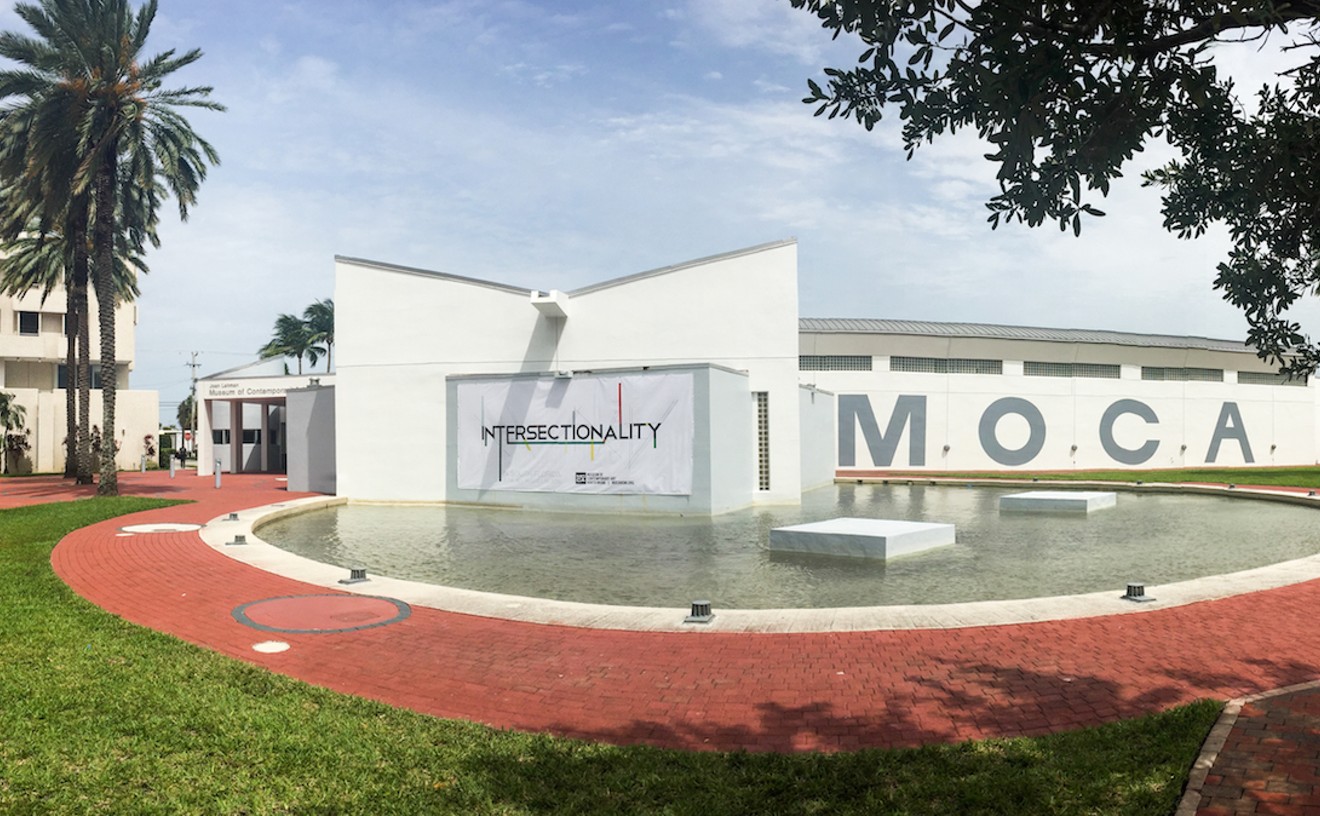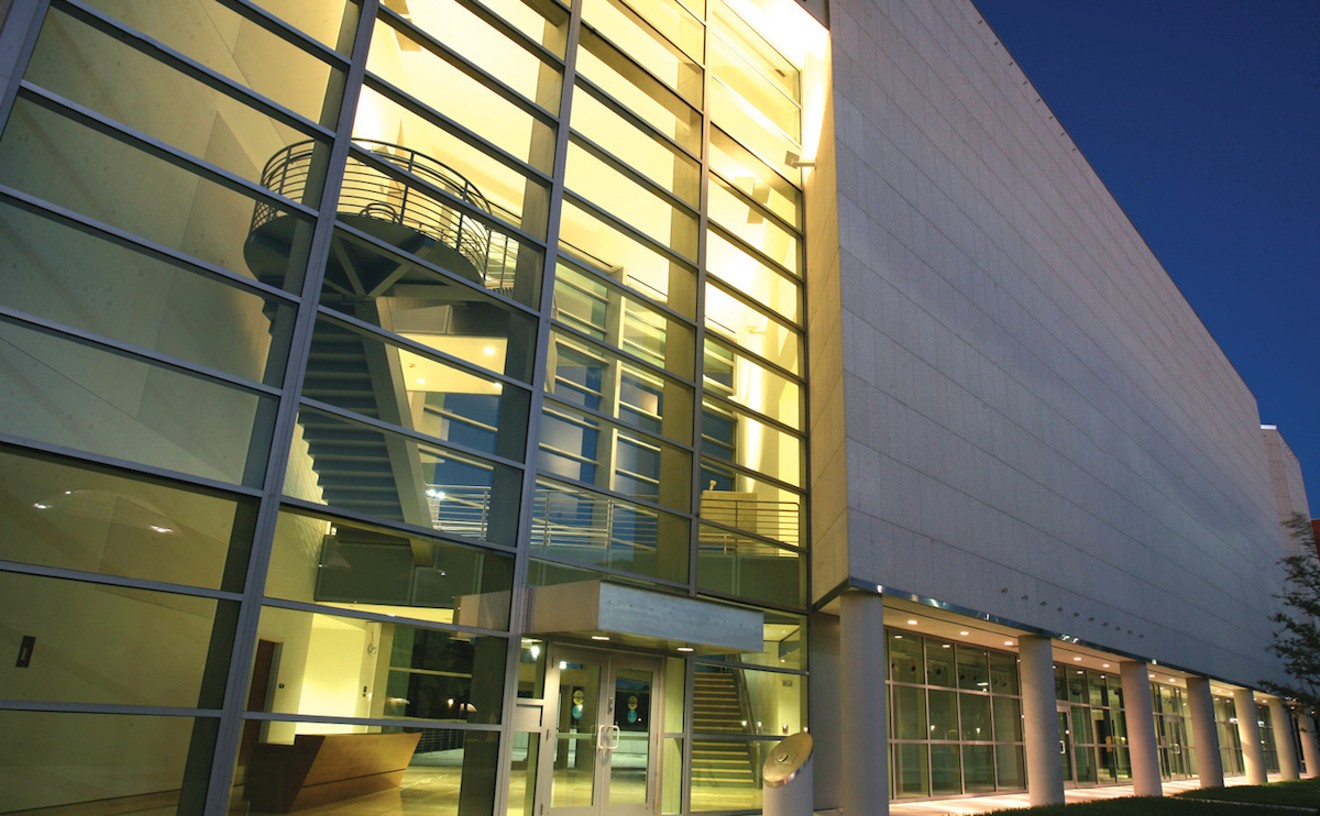Sympathy for the Devil Art and Rock and Roll Since 1967 Book

Courtesy of the Museum of Gimmicky Art
This nearly pitch-perfect exhibition, organized by curator Dominic Molon over a 5-twelvemonth span, explored the deep-rooted and central alliances betwixt rebellious spirits haunting both the sonic and visual realms. It featured more 100 paintings, drawings, installations, and videos past 56 artists and artist collectives. The show was organized by the Museum of Contemporary Art in Chicago, where it drew stadium-size crowds. MoCA's turnstile numbers skyrocketed as well. Although some knuckleheads wailed about holes in the exhibition's version of rock history, y'all couldn't leave without giving this devil his due.
- 770 NE 125th St., N Miami, 33161 Map
- 305-893-6211
- mocanomi.org
"I won't exist punked," Florida Congresswoman Ileana Ros-Lehtinen proclaimed.
After all, former vice presidential candidate Sarah Palin was duped by a radio station into taking a telephone call from a faux French President Nicolas Sarkozy. So when President-elect Barack Obama called to congratulate Ros-Lehtinen on her re-ballot victory — a move he hoped would build a bridge of nonpartisanship with the Republican congresswoman — well, Ileana would non be punked like Sarah was.
"You are either very gracious to reach out in such a bipartisan style or had run out of folks to telephone call if you are truly calling me," Ros-Lehtinen told the prankster. "And Saturday Night Live could apply a skilful Obama impersonator like yous." And and so she hung up. Shortly later, she received a call from Rahm Emanuel, telling her that she had just hung up on the president. Again, Ros-Lehtinen would not be fooled! And hung upwards. Once more. Trouble is, it really was President-elect Obama and his master of staff calling. Information technology wasn't until a fellow member of the U.South. House of Representatives, Howard Berman, called to assure her that she was non the target of a prank that Ros-Lehtinen finally took the call from the POTUS. After all, who the hell does impressions of Howard Berman?
It was right at that place in black-and-white, on the cover of your Miami New Times: "Terminate of the Diaz-Balart Dynasty." Simply weeks before election night, scores of polls showed both Mario and Lincoln — Cuban-American icons and Miami's reps in Washington for years — abaft their Democratic challengers. Obama-chin was sweeping the nation, ripping Ruby-red State seats out from under longtime untouchables. Immature Cuban-Americans, everyone said, were ready for a modify and didn't feel tied to the Republican Party the way their parents did.
Then November four rolled around. Like Castro-hating, earmark-eating zombies, the Diaz-Balarts rose from the political graveyard and dominated the polls. Lincoln won 58-42 over former Hialeah Mayor Raul Martinez. Mario smacked down wonder male child Joe Garcia by four points. And the dynasty, for another two years, lives on.
Wet Estrus offers an insightful take on a critical moment for our city and the cultural engine driving it. During the past 18 months, Bill Bilowit and Grela Orihuela, originators of the popular site, have been producing documentary content chronicling Miami's new identity as a global arts destination and the players fueling its rise. They began screening the projection during terminal December 2008's Art Basel confab. The arts confluence unfolding on their doorstep and the opportunity to chronicle living history is the Ariadne'due south thread that binds these films. "Each edition is an in-depth, cinéma vérité, backside-the-scenes contour of a Miami-based artist at a milestone moment in their career," Bilowit states. He and Orihuela recently wrapped filming locals Bert Rodriguez and Hernan Bas for hourlong documentaries respectively, excerpts of which can be viewed online. The documentaries shadow the artists in their studios and at art openings and fairs, and characteristic interviews with dealers, collectors, critics, and loftier-fine art honchos, conveying their development as artists as well as telling the story of Miami'southward dramatic upswing.
Miami has a graffiti style all its own — wild, imaginative, and full of tropical color. MSG Cartel claims it's only an "online exhibition" of graffiti, implying its contributors are simply admirers of that item street fine art. But browse the site — named for graffiti crew Miami Style Gods — for a while and information technology becomes clear it's operated by, and is a meeting ground for, Miami'due south near prolific illegal artists, from Crome and Cheat to Atomik. The photos posted constitute a de facto hall of fame for some of the virtually skilled local wall work. Afterward Kendall graffiti artist Merk fell to his death while spray-painting a highway overpass, the blog became a memorial ground. It's a daily updated finger on the pulse of a naturally reclusive subculture.
For the first time in decades, since before John F. Kennedy allegedly betrayed them, Cuban-Americans in Miami were supposedly ready to accept the Democratic Party into their lives over again. Focus groups and studies indicated that Cuban-Americans in Miami wanted the freedom to travel to Cuba and visit relatives, not to mention ship them money. Polls showed that, like the rest of America, Cuban-Americans wanted leaders who would focus on fixing the local economy instead of being fixated on toppling Fidel Castro. These were the signs that propelled the Democratic Party to recruit Hialeah's Mayor-for-Life Raul Martinez out of retirement and become after Rep. Lincoln Diaz-Balart'southward seat. From the starting time, the campaign was billed as the clash of the titans. It was the blazon of political race fabricated for national television. On one side was Diaz-Balart, a one-time state prosecutor whose congressional career has been defined by a singular subject — the Cuban embargo. On the other side was Martinez, the charismatic Cuban Democrat who built his legacy running Miami-Dade's second-largest urban center. The plan seemed perfect. Martinez would siphon votes abroad from Diaz-Balart'due south base in Hialeah while clobbering the U.S. representative in Democrat-loving Broward County. Pundits figured Diaz-Balart was in the fight of his political life. They claimed he was in a dead heat with Martinez and the race was too close to call. But everyone underestimated Diaz-Balart, who proved he tin can still go nasty and dirty to get a victory. Throughout the campaign, Diaz-Balart hammered home Martinez's troubled by, including his indictment on public corruption charges and video footage of the burly Martinez pummeling a smaller homo during a street protestation. Martinez was unable to thwart the barrage confronting his grapheme and ended up losing to Diaz-Balart past double digits. So much for those focus groups.
You know that old saying, "He could sell popsicles to an Eskimo"?
It's officially been revised, equally of March 24, 2009, to read: "He could sell taxpayers a $600 million stadium during the worst economic meltdown in modern history."
Jeffrey Loria, owner of the Florida Marlins, put on a clinic in chutzpah this spring when he steamrolled through the urban center and canton commissions with a $634 million deal for a retractable-roof stadium in Little Havana.
All this while the American economy expiry-spiraled and South Florida sank under a real manor market tanking harder than Dontrelle Willis's career. And best of all, Loria persuaded the council to pay for most of the bargain — all only $120 million worth — with taxes.
Loria, who earned his billions selling art, is officially the Rembrandt of chutzpah.

Florida International University
At the Frost's gorgeous new building, local kids finally have a place to channel their inner van Gogh or Warhol in a setting that invites creativity. This state-of-the-fine art gallery allows visitors to enjoy interactive activities designed to educate, entertain, and enhance the museum experience. The gallery boasts 13 stations, including the computer-based display "Picture Yourself," where a camera snaps an image of the user's face and reproduces information technology on a affect screen. Participants can then trace the contours of the face with their fingers and print the finished artwork to have home. And, best of all, entrance to the gallery and museum is free yr-round.
- 10975 SW 17th St., Miami, 33199 Map
- 305-348-2890
- frostartmuseum.org

Florida International University
The sparkling debut of Miami'south first new museum in a decade was greeted with critical acclaim and thunderclaps of applause from the public when the Frost reopened its doors this past November. Designed by Yann Weymouth, the 46,000-foursquare-foot building is a work of fine art that rivaled the impressive exhibits organized for the unveiling. The museum boasts a dazzling Chinese granite façade, a soaring atrium, and a floating stairwell, and features more than 10,000 square feet of exhibition space.
Inside the concave-shaped gem, galleries are bathed with natural light filtered through skylights. Its ceilings are covered with fiberglass petals that protect the art from the sun's ultraviolet rays. The Frost christened its new home with vi exhibitions, including "Modernistic Masters from the Smithsonian," which featured 43 primal paintings and sculptures by 31 of the most celebrated artists who came to maturity in the 1950s. The sprawling show examined the complex and varied nature of American abstract fine art in the mid-20th Century.
Add to the fresh new museum smell a bold exhibition schedule and the Steven and Dorothea Light-green Critics' Lecture Series, and the expedition to the hinterlands becomes more than of a joyous cultural pilgrimage than a headache. The museum's new Target Wednesday After-Hours programming likewise gives visitors the risk to engage in gallery talks, visiting creative person lectures, films, alive music, and performance art the first Wednesday of every month. And, unlike other local museums, admission to the Frost and its programs are free to the public.
- 10975 SW 17th St., Miami, 33199 Map
- 305-348-2890
- frostartmuseum.org
As we enter the concluding, gasping, dying breaths of the newspaper era, it is nice to see there are nonetheless a few Miami Herald veterans who continue to put out insightful, probing, hard-striking journalism. At a fourth dimension when thousands of unemployed shoe leather scribes are contemplating how they're gonna turn their buyout into the next large new media risk, guys and gals similar Larry Lebowitz keep churning out news articles that go out your fingers black with ink. And his words are worth every stain, because Lebowitz knows Miami-Dade County better than the guy who has to have a Metrobus from his house in Homestead to his job in Aventura. For more a decade, Lebowitz has produced an impressive cache of clips. When he was the Herald'south court reporter, Lebowitz wrote about everything from Deerfield Beach gun smugglers doing business organization with the Irish Republican Army to the story of a federal judge who went after a couple of DEA agents who defied a court order barring them from using a convicted smuggler in a sting. Lebowitz has gone on to shine every bit the Herald'due south transportation guru. Through his weekly column, "Streetwise," Lebowitz takes local regime officials to job by exposing the never-ending bungling of the half-penny sales taxation to fund mass transit in Miami-Dade while also offering his own perspective on how to make commuting bearable in sun-soaked traffic jams. In 2007, Lebowitz was honored past the South Florida Society of Professional Journalists when he and Debbie Cenziper won the James Crossbar Award for Public Service Journalism and the Gene Miller Award for Investigative Reporting for the "House of Lies" series. We only hope the Herald doesn't implode so that Lebowitz can keep his job.
Source: https://www.miaminewtimes.com/best-of/2009/people-and-places/best-art-exhibit-6402117
0 Response to "Sympathy for the Devil Art and Rock and Roll Since 1967 Book"
Post a Comment